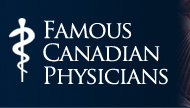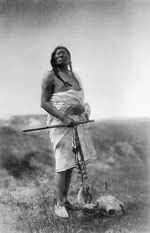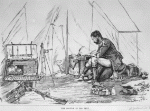| Home > Browse Selected Topics > Famous Canadian Physicians | Franšais | |
 
 History of Medicine in CanadaMedicine in Canada began long before the arrival of French settlers. First Nations passed on their traditions orally; however, only a few written accounts of their practices were recorded by white settlers. Most aspects of First Nations medicine were linked with spiritual beliefs. For example, disease was understood to stem largely from spiritual causes and therefore required spiritual cures. These cures were generally provided by a Shaman, or Medicine Man.  Source First Nations also treated illness with different plant remedies -- oil of wintergreen and bloodroot were effective -- and with physical procedures such as sweat lodges and massages. First surgeonsWhen New France was ceded to the British, it was military surgeons who dominated the medical system. The early settlers in Upper Canada and the First Nations they had contact with succumbed to many infectious diseases. Many of these diseases, such as measles, typhoid, diphtheria and smallpox, had not existed in North America previously, but were brought to Canada by the Europeans. If there were no physicians available, people treated themselves with home remedies and botanic cures based on First Nations prescriptions. Midwives usually assisted at childbirth.  Source 
Source 
Source A doctor from the Maritimes, David Parker, was the first in Canada to operate with the help of anaesthesia. In B.C., William Fraser Tolmie, who worked as a surgeon and trader for the Hudson's Bay Company, may have performed one of the first modern operations on the West Coast when he removed a tumour from the breast of a sailor. First medical schoolsMany physicians arrived in Canada as immigrants, mainly from Britain and the United States. They helped establish the first medical schools in Upper Canada in the 1820s. One of these schools became the medical department at Victoria University. Another, the Montreal Medical Institution, was absorbed by the medical faculty of McGill University in 1923. In the 1850s, students in Canadian medical schools attended lectures but were offered very little laboratory work. Facilities were basic and there was hardly any "hands-on" experience. It was not until the mid-1870s that William Osler, a renowned and gifted teacher, took over the chair at the medical school at McGill and introduced the use of microscopes and dissection into his anatomy classes. 
Source 
Source ![Photograph of Dr. Wilfred Grenfell examining young patient, in company of nurses, circa 1905-1915, Harrington Harbour, [Quebec]](/web/20061121031323im_/http://www.lac-bac.gc.ca/obj/002032/f1/a178342-v2.jpg)
Source In 1839, a group of Toronto physicians was incorporated as the College of Physicians and Surgeons of Upper Canada. But its incorporating act was disallowed in 1840. A new College, empowered to examine would-be practitioners and university graduates, was formed in 1869. EpidemicsAs the population of British North America increased, so did its susceptibility to disease. Cholera struck in 1832, 1834 and 1849 as well as during the 1850s. Doctors disagreed over whether it was contagious. In 1834, William Kelly, a surgeon with the Royal Navy, suggested there was a relationship between diseases, such as cholera, and sanitation. By the end of the century, officials began to actively promote adequate sanitation and clean water and to introduce vaccines to combat diseases such as smallpox. Two major discoveriesIn the 19th century, there were two major breakthroughs in the field of medicine. The first, in the 1840s, was the discovery of anaesthetic, which rendered surgery painless. The second was made by the Englishman Joseph Lister, who proved that the recovery rate of patients suffering from wounds could be greatly improved if the wounds were disinfected. Until then, surgeons rarely sterilized their equipment and washed their hands in only a cursory fashion. It did not take long before Lister's antiseptic treatment was being used in operating rooms throughout the country. Female physiciansIn the 1850s, Canadian women were still denied admission to Canadian medical schools. This meant that aspiring female physicians, including Emily Stowe and Jennie Trout, had to train in schools outside Canada. It was only in 1871 that both women were finally admitted to the Toronto School of Medicine; they went on to be the first women granted medical licences by the College of Physicians and Surgeons of Ontario. In 1883, pressure from the Toronto Women's Suffrage Association, spearheaded by Emily Stowe, led to the creation of the Ontario Medical College for Women, which was affiliated with the University of Toronto. Landmark textOf the 19th-century doctors who contributed to the prestige of medicine both in Canada and abroad, the most notable was William Osler. Osler was educated at the Toronto School of Medicine and at McGill University, where he eventually joined the medical faculty. He went on to teach medicine at the University of Pennsylvania, at Johns Hopkins Hospital and Medical School and (as Regius Professor of Medicine) at Oxford University. In 1892, he wrote a landmark book, The Principles and Practice of Medicine, which became the most important medical text for the next 40 years. His emphasis on the study of anatomy and on bedside teaching transformed medical teaching in North America. Twentieth-century developmentsMedical research in Canada was accelerated by two important medical breakthroughs early in the century. The first was the discovery of insulin by Frederick Banting and his colleagues, Charles Best and J.J.R. MacLeod, in 1922. Their discovery has saved or transformed the lives of millions of people with diabetes. Second, in 1934, thanks to a grant from the Rockefeller Foundation, Wilder Penfield founded the Montreal Neurological Institute to provide facilities for studies of the brain. He is best known for his discovery of a surgical treatment for epilepsy. 
Source In the years before the Second World War, it was learned that several diseases could be controlled by immunization. This, together with the widespread benefits of improved diet and nutrition, did much to prevent disease and extend people's lives. Also, hospitals became safer places for the sick, and surgical procedures became more sophisticated and more likely to achieve satisfactory results. The discovery of sulfa drugs in the 1930s proved to be the forerunner to the arrival of antibiotics, which also contributed to the control of disease. Today, people live healthier and longer lives thanks to the perseverance and diligence of their forebears who helped fight disease and improve the quality of lives. Many Canadian doctors helped influence the development of their own country, not only as physicians, but also as politicians, inventors, explorers and soldiers. Others became known for their work outside Canada, such as Robert McClure, Davidson Black and Norman Bethune, for their work in China. |